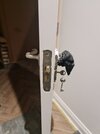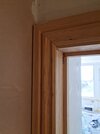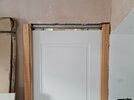I am working on a "building site". Not something I do very often. And kinda regretting it given that the place is so chuffin' messy.
After seeing the following...

I recommended that the builder buy his "carpenter" a Souber.
The above is not the only face palm moment. Door architraves with joins half the way along (unglued joins).
Architraves that don't maintain a constant distance from the door liner.

Pocket doors that can't be fully closed because the customer specified finger pull handles that are flush.
Pocket doors, the frame of which has been cut in to the plasterboard on one side but not the other.

To be fair most of the skirting boards are pretty good but some were glued using silicone and they have smeared silicone over the face of the skirting.
The door stops throughout are about 15(?)mm deep even though the doors are 30 mins fire check.
The customer wants all doors painted black but ordered white pre-primed doors. The customer has also specified water based paints. The doors that had been painted before I started all scratch if you run your finger nail over them.
On Saturday they needed to fit a door liner in the hallway. They then soon realised that the liner needed to be shunted by 10 inches. They ran an angle grinder down the wall and the carpenter proceeded to hack out the inch thick plaster. He didn't seem particularly bothered about the fact that the large lumps were crashing down on the vinyl strip flooring that had been fitted the day before. (No one was concerned about the amount of dust sent up the finished floor above.)
Needless to say there are lots of scratches in the new flooring.
I have worked on a few building sites. At this stage in the job, this is far and away the messiest and least organised site I have ever worked on. I can be painting a wall, the electrician will walk in and use an oscillating saw to move a light switch or use a hole saw to move a ceiling light fitting. He then whacks in "bonding/browning" plaster. If I catch him doing it, I scrape it flush before it sets.
Site PPE is limited to gloves- that's it. The "tiler" was angle grinding tiles and got a chip in his eye, he got a colleague to use his dirty fingers to try remove it. I have seen no evidence of a first aid kit. I have since found a small fire extinguisher.
One day I noticed that, after their running out of toilet paper, they were now flushing the blue paper down the loo. I sent a text to the guy paying me and informed him that blue paper doesn't break down in water and that he should get some loo paper before the sewer becomes blocked.
I was working in one of the bathrooms on Saturday, trying to force feed paint to the silicone used by the electrician to hold the ceiling extractor fan up, some guy walks in and started peeing in the loo right next to my step ladder. I climbed down and left the room.
Sorry about the rant, it is doing my head in. I don't want to let the building contractor down, but he is making unrealistic demands of his decorator and I. I left site at 14.30, having got there at 06.30. When I left, there will still architraves in some of the unfinished rooms that are 8mm away from the pocket door frames. Slightly more than "paint fill" me thinks...




